Portal:Television/Selected picture
Selected pictures list
Selected picture 1
Portal:Television/Selected picture/1

A professional video camera (often called a television camera even though the use has spread) is a high-end device for recording electronic moving images (as opposed to a movie camera, that records the images on film).
Selected picture 2
Portal:Television/Selected picture/2

A television station is a type of broadcast station that broadcasts both audio and video to television receivers in a particular area. Traditionally, TV stations made their broadcasts by sending specially-encoded radio signals over the air, called terrestrial television. Individual television stations are usually granted licenses by a government agency to use a particular section of the radio spectrum (a channel) through which they send their signals.
Selected picture 3
Portal:Television/Selected picture/3
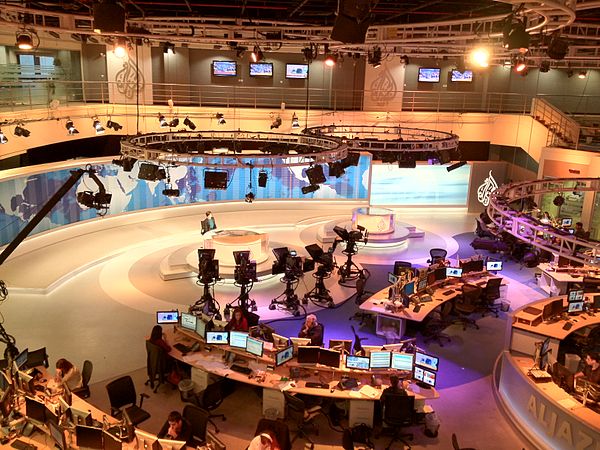
A television studio is an installation in which television or video productions take place, either for live television, for recording live to tape, or for the acquisition of raw footage for postproduction. The design of a studio is similar to, and derived from, movie studios, with a few amendments for the special requirements of television production.
Selected picture 4
Portal:Television/Selected picture/4

A newscast typically consists of the coverage of various news events and other information, either produced locally in a radio or television station newsroom, or by a broadcast network. It may also include such additional material as sports coverage, weather forecasts, traffic reports, commentary and other material that the broadcaster feels is relevant to their audience.
Selected picture 5
Portal:Television/Selected picture/5

The Jacob's Awards were instituted in December 1962 as the first Irish television awards. Later, they were expanded to include radio. The awards were named after their sponsor, W. & R. Jacob & Co. Ltd., a biscuit manufacturer, and recipients were selected by Ireland's national newspaper TV and radio critics. Jacob's Award winners were chosen annually until 1993, when the final awards presentation took place.
Selected picture 6
Portal:Television/Selected picture/6

The Emmy Award is an American television production award, similar in nature to the Peabody Awards but more focused on entertainment, and is considered the TV equivalent of the Oscars. The best-known of the awards are the Primetime Emmys, and the Daytime Emmy Awards, with both having categories classified as Creative Arts Emmys.
Selected picture 7
Portal:Television/Selected picture/7

A satellite dish is a type of parabolic antenna designed with the specific purpose of transmitting signals to and/or receiving from satellites. A satellite dish is a particular type of microwave antenna. Satellite dishes come in varying sizes and designs, and are most commonly used to receive satellite television.
Selected picture 8
Portal:Television/Selected picture/8

The Federal Communications Commission (FCC) is a United States government agency, created, directed, and empowered by Congressional statute (see 47 U.S.C. § 151 and 47 U.S.C. § 154), and with the majority of its commissioners appointed by the current president. The FCC was established by the Communications Act of 1934 as the successor to the Federal Radio Commission and is charged with regulating all non-Federal Government use of the radio spectrum (including radio and television broadcasting), and all interstate telecommunications (wire, satellite and cable) as well as all international communications that originate or terminate in the United States.
Selected picture 9
Portal:Television/Selected picture/9
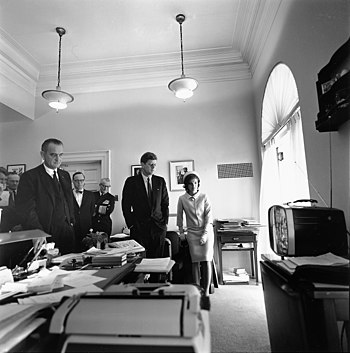
John F. Kennedy, Lyndon B. Johnson, and others watching flight of Astronaut Alan Shepard on television. Shepard was the second person and the first American in space. He later commanded the Apollo 14 mission, and was the fifth person to walk on the moon.
Selected picture 10
Portal:Television/Selected picture/10
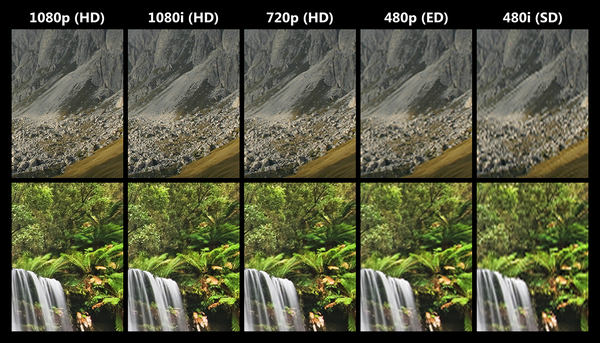
High-definition television (HDTV) is a digital television broadcasting system with greater resolution than traditional television systems (NTSC, SECAM, PAL). HDTV is digitally broadcast, because digital television (DTV) requires less bandwidth if sufficient video compression is used. HDTV technology was introduced in the United States in the 1990s by the Digital HDTV Grand Alliance, a group of television companies.
Selected picture 11
Portal:Television/Selected picture/11

A teleprompter (also known as an autocue) is a display device that prompts the person speaking with an electronic visual text of a speech or script. Using a teleprompter is similar to the practice of using cue cards.
Selected picture 12
Portal:Television/Selected picture/12

Digital television (DTV) is a telecommunication system for broadcasting and receiving moving pictures and sound by means of digital signals, in contrast to analog signals used by analog (traditional) TV. DTV uses digital modulation data, which is digitally compressed and requires decoding by a specially designed television set, or a standard receiver with a set-top box, or a PC fitted with a television card.
Selected picture 13
Portal:Television/Selected picture/13

Phonevision, also known as station KS2XBS, was an experimental television station in Chicago, Illinois, owned and operated by Zenith. It was the world's first pay television station. Zenith originally occupied the VHF Channel 2 frequencies since 1939, using this as an experimental station while they tried to perfect "PhoneVision".
Selected picture 14
Portal:Television/Selected picture/14

Cable News Network, commonly referred to by its initialism CNN, is a major news cable television network founded in 1980 by Ted Turner. The network is now owned by Time Warner; the news network is a division of the Turner Broadcasting System. CNN introduced the idea of 24-hour television news coverage, celebrating its 25th anniversary on June 1, 2005.
Selected picture 15
Portal:Television/Selected picture/15
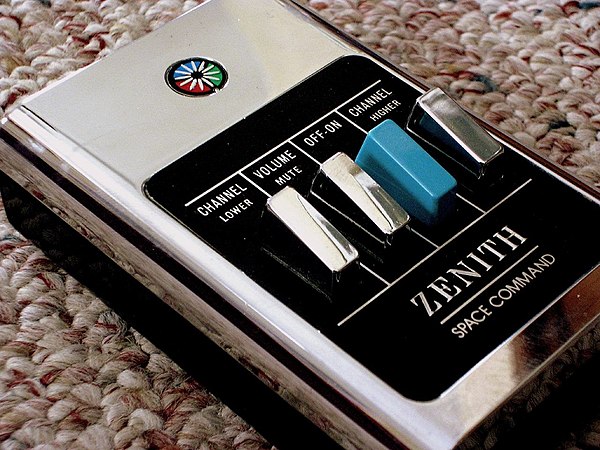
A remote control is an electronic device used for the remote operation of a machine. The term remote control can be also referred to as "remote" or "controller" when abbreviated. It is known by many other names as well, such as the "clicker", "channel-changer", "splat", "magic hand", etc. Commonly, remote controls are used to issue commands from a distance to televisions or other consumer electronics such as stereo systems and DVD players.
Selected picture 16
Portal:Television/Selected picture/16
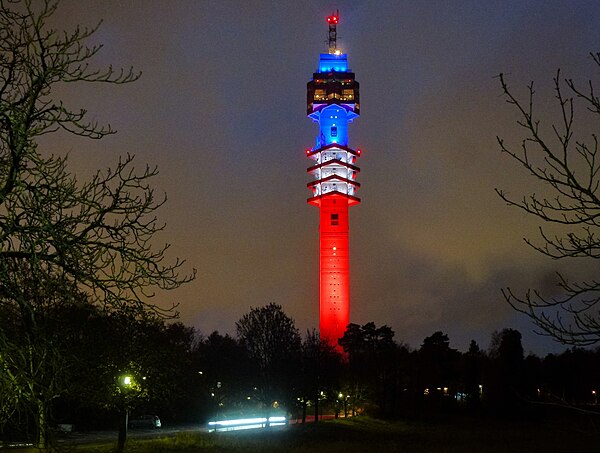
The Kaknäs tower (Swedish: Kaknästornet) is a TV tower in Gärdet in Stockholm, Sweden. It has 72 pillars. The tower is a major hub of Swedish television, radio and satellite broadcasts. It was finished in 1967, designed by architect Bengt Lindroos, and the height is 155 metres (509 ft) or 170 metres (560 ft) with the antenna included. The tower is owned by the national Swedish broadcasting company Teracom. The tower's name comes from the ancient name of the area, Kaknäs.
Selected picture 17
Portal:Television/Selected picture/17

Pixelization is a video- and image-editing technique where an image, or part of it, is blurred by displaying part or all of it at a markedly lower resolution. A familiar example of pixelization can be found in television news and documentary productions, where vehicle license plates and faces of suspects at crime scenes are routinely obscured to maintain the presumption of innocence, as in the television series COPS.
Selected picture 18
Portal:Television/Selected picture/18

Closed captioning (CC) and subtitling are both processes of displaying text on a television, video screen, or other visual display to provide additional or interpretive information. Both are typically used as a transcription of the audio portion of a program as it occurs (either verbatim or in edited form), sometimes including descriptions of non-speech elements. Other uses have been to provide a textual alternative language translation of a presentation's primary audio language that is usually burned-in (or "open") to the video and not selectable (or "closed"). HTML5 defines subtitles as a "transcription or translation of the dialogue ... when sound is available but not understood" by the viewer (for example, dialogue in a foreign language) and captions as a "transcription or translation of the dialogue, sound effects, relevant musical cues, and other relevant audio information ... when sound is unavailable or not clearly audible" (for example, when audio is muted or the viewer is deaf or hard of hearing").
Selected picture 19
Portal:Television/Selected picture/19

Early television model, from 1936, produced by Telefunken, Germany
Selected picture 20
Portal:Television/Selected picture/20

Fuji Television Network, Inc. Kabushiki Gaisha Fuji Terebijon is a Japanese television network based in Odaiba, Minato-ku, Tokyo, Japan. It is known as Fuji TV Fuji Terebi or CX. It is the flagship TV station of Fuji News Network (FNN) and Fuji Network System or FNS. It also has a relationship with Nippon Broadcasting System, Inc.
Selected picture 21
Portal:Television/Selected picture/21

The CN Tower, Toronto, Canada, used for television transmission, among other uses
Selected picture 22
Portal:Television/Selected picture/22
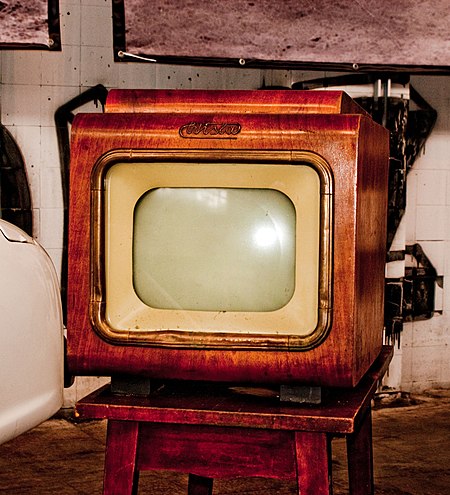
CRT TV set "Wisła" ("Vistula") made in Poland, since 1955, by Warszawskie Zakłady Telewizyjne
Selected picture 23
Selected picture 24
Portal:Television/Selected picture/24
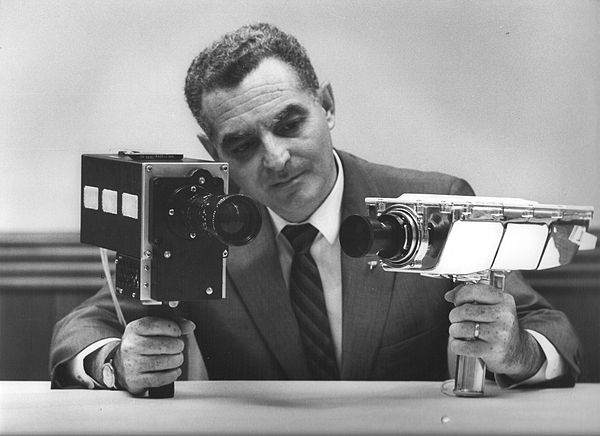
The Apollo TV camera refers to several television cameras used in the Apollo program's space missions, and on the later Skylab and Apollo-Soyuz Test Project missions, in the late 1960s and 1970s. These cameras varied in design, with image quality improving significantly with each successive model. Two companies made these various camera systems: RCA and Westinghouse. Originally, these slow-scan television (SSTV) cameras, running at 10 frames-per-second (fps), produced only black-and-white pictures and first flew on the Apollo 7 mission in October 1968. A color camera — using a field-sequential color system — flew on the Apollo 10 mission in May 1969, and every mission after that. The Color Camera ran at the North American standard 30 fps. The cameras all used image pickup tubes that were initially fragile, as one was irreparably damaged during the live broadcast of the Apollo 12 mission's first moonwalk. Starting with the Apollo 15 mission, a more robust, damage-resistant camera was used on the lunar surface. All of these cameras required signal processing back on Earth to make the frame rate and color encoding compatible with analog broadcast television standards.
Selected picture 25
Portal:Television/Selected picture/25

W2XBS, Schenectady, New York. In 1928, Felix the Cat was one of the first images ever broadcast by television when RCA chose a papier-mâché Felix doll for an experimental broadcast on W2XBS. The doll was chosen for its tonal contrast and its ability to withstand the intense lights needed in early television and was placed on a rotating phonograph turntable and televised for about two hours each day. The doll remained on the turntable for nearly a decade as RCA fine-tuned the picture's definition, and converted to electronic television.
Selected picture 26
Selected picture 27
Selected picture 28
Selected picture 29
Selected picture 30
Usage
The layout design for these subpages is at Portal:Television/Selected picture/Layout.
- Add a new Selected picture to the next available subpage.
- Update "max=" to new total for its {{Random portal component}} on the main page.
Nominations
Feel free to add related featured pictures to the above list. Other pictures may be nominated here.

